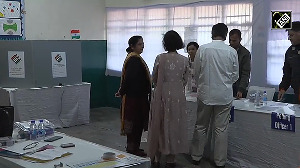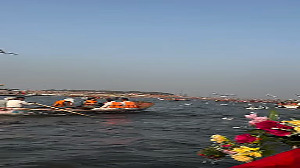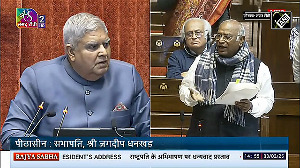Monica Nayyar Patnaik, director, Radio Choklate, owned by the Samvaad newspaper group of Orissa, is both pleased and worried.
Pleased because her FM radio station, launched in Bhubaneswar two months ago, has been well received. And worried because two rival stations - one each by Adlabs and South Asia FM - are already up and running in the city.
"We are getting a positive response but it's not an easy business," she says. "Music royalties are steep and eat into our revenues."
Vivek Singhal, a property dealer in Hisar, Haryana, who launched Radio Tarang there some time ago, faces a similar challenge. Already his station is competing with three other players in a market with inconsequential advertising.
"It's too early to talk about the kind of advertising we'll be able to tap," he says, even though he remains spirited about the venture.
You could dismiss Patnaik's and Singhal's fears as the misgivings of a couple of first-timers in the radio business until you hear Radio Mirchi's deputy CEO Prashant Panday's startling observation: "Of the 91 cities where FM radio frequencies were auctioned last year, nearly 50 are unviable owing partly to smaller revenue potential and largely because of the cost structure."
Run by Entertainment Network India Limited, Radio Mirchi is Times Group's FM station brand started during the first phase of radio privatisation in 2000.
The radio operators' remarks are significant in view of the July 23 deadline laid by the government for the pre-qualification round to the FM radio bids scheduled for November 2007.
The pre-qualification bids are being held for 97 frequencies, mostly "leftovers" from the last round or those "surrendered" by the radio companies after phase II of FM radio privatisation was completed last year.
The biggest test for station owners is keeping the cost of operating a radio station under control. The gripe comes as a huge surprise since the government gave in to the demands of the private operators and altered the radio policy in the last auction.
It moved from the ascending fee based system (which escalated by 10 per cent every year) to a revenue share arrangement (4 per cent) with the radio operators. And they still can't make money?
Radio industry executives quickly offer bona fide reasons for their tribulations. For a start, they claim that the cost of music rights, the mainstay of radio stations, is very high.
The estimates of how much a radio company pays PPL (Phonographic Performance Limited), the body that represents the interests of the music companies, vary from 20 per cent to 40 per cent share of its revenue.
Complains Rahul Gupta, director, Radio Mantra, owned by Dainik Jagran's Shri Puran Multimedia, "Content for radio is limited to music and the music industry's demands are astonishingly high, not even remotely in line with global standards."
The international benchmark on revenue share between music owners and radio stations is between 2 per cent and 4 per cent, he claims.
That is not all. Even as radio stations crop up in class C and D towns, PPL is not offering differential pricing for the music.
"I am being charged the same amount for a song as my counterpart in, say, Mumbai. Hisar's revenue potential cannot be the same as that of a metro," argues Singhal. Roughly the cost of music works out to Rs 1,320 per needle hour and stations play music 18 hours a day.
Some months ago, radio operators sought the help of the information and broadcasting ministry to resolve the music royalty issue. Since PPL and IPRS (Indian Performing Rights Society, which also charges royalty from radio stations) fall under the human and resource development ministry, I&B could only request the warring parties to talk across the table.
The FM radio body, Association of Radio Operators of India, appointed a four-member committee to talk to PPL but there's been no progress yet.
AROI's contention is that PPL avoids talking to the body as it loses its bargaining power to negotiate rates with individual radio stations. Vipul Pradhan, CEO, PPL, fumes at the allegations. "Didn't they take content cost into account when bidding?"
After royalties (T-Series and Yash Raj Music negotiate separately since they are not part of PPL), the next major cost is human resource, marketing and branding.
"The number of stations has grown from 20 to 200 leading to a talent crunch and resulting in spiralling manpower costs," says Manajit Ghoshal, CFO at Mid-Day Multimedia that operates Radio One in Mumbai, Delhi, Bangalore and Chennai.
Add to these the one-time licence fee the operators have paid to the government, the investment in studios and the payments to Prasar Bharti to use its transmission towers.
"Collectively, we have paid Rs 1,300 crore (Rs 13 billion) as one-time entry fee to the government and invested another Rs 1,000 crore as capital expenditure. The industry will take years to generate the kind of money we have given away as entry fee," says Radio Mirchi's Panday.
He cites the example of a small town like Vadodara where radio spends would be about Rs 2.5 crore (Rs 25 million) a year. This has to be shared by four radio stations and, usually, the leader decamps with the largest chunk of the revenue.
Considering the stations will shell out Rs 50 lakh (Rs 5 million) each in music royalties, give away 4 per cent of their revenues to the government and have another Rs 35-40 lakh (Rs 3.5-4 million) as miscellaneous expenses (HR, marketing, Prasar Bharti's fees, generator cost etc), it is unlikely they will make money in a hurry, Panday feels.
While they may be losing sleep over costs, the last Indian Listenership Track, a quarterly study conducted by Media Research User's Council has not given the private operators any reason to cheer either.
Despite a host of new radio stations launched in the two cities in the last eight months, the listenership has grown merely 6 per cent in Mumbai and 8 per cent in Delhi. Growth in Kolkata was almost static at 1.14 per cent.
Says Sajjad Chunawala, the Mumbai station head of Hindustan Times' Fever 104 FM, "Delhi's listenership is barely 65 lakh (Rs 6.5 million). There should be at least 1 crore (10 million) radio listeners in the city as it is a free medium."
It is likely the 20-25 per cent growth in radio has come from geographical expansion. Besides, the rate of growth is much lower than that of television, which grew virtually at 100 per cent a year when it exploded in the early 1990s.
"In advertising terms, too, we have a long way to go. Radio is still an add-on medium. No campaigns are made with radio in mind," observes Chunawala. Though new stations added substantial advertising inventory, industry insiders say only 50 per cent of it has been soaked up. Radio heads are hopeful that advertising will pick up by September, in time for the festival season.
But the radio industry is not too bullish about any increase in ad spends. ADEX, TAM Media's division on media spends, estimates that radio generated roughly Rs 480 crore (Rs 4.8 billion) in advertising in 2006.
However, industry veteran Gautam Radia pegs it closer to Rs 350 crore (Rs 3.5 billion) in view of the huge discounts offered by the operators. Depending on the city, a 10-second radio spot could be selling at anywhere between Rs 50 per and Rs 1,200.
The industry, which anticipates making a loss of Rs 120 crore (Rs 1.2 billion) this year, is also unlikely to reach the projected 7-8 per cent share of total advertising in the short term.
"Despite the buzz and predictions, radio's share has not moved beyond 3 per cent," points out Radia.
Manish Porwal, managing director (India, south and west) of the media agency Starcom, is not sure when radio's share of advertising would touch 7-8 per cent. "It may go up to 6 per cent in three years. The biggest roadblock is the absence of syndicated study."
Besides, the growth of the medium will depend on the growth of organised retail, he adds. That TAM Media Research has also set up a radio listenership measurement system recently, may help the industry.
Yet, Radio City CEO Apurva Purohit holds the radio industry responsible for underselling the medium. "We have not marketed the medium well enough. This has led to radio taking a position slightly lower than what it could command because of its strengths."
To be sure, the government regulations are partly to be blamed for the industry's less than sizzling growth. The policy insists that radio operators use common transmission infrastructure for relaying their signals.
Only BECIL, the engineering consultancy company of the government, is mandated to set up the infrastructure. Needless to say, the process has been slow and tedious, delaying several launch schedules.
Of the 16 frequencies that Radio City won, it has launched stations in only four cities. Reliance ADAG's Big FM won 45 stations and only 22 are on air.
Says Tarun Katial, CEO, Big FM: "Delayed infrastructure is definitely affecting business and expansion plans." Big FM, for instance, has recruited people at several stations that have not taken off, resulting in high overhead costs.
Adds Purohit, "The common infrastructure is taking three to six months to be delivered, affecting the schedule of several operators."
But mandatory use of common infrastructure is only part of the problem. Not allowed to carry news and current affairs programming or live sports like cricket, the players are totally dependent on music. Besides, a single player is not allowed multiple frequencies in a city. This does not allow room for product differentiation since the stations have to take the popular route to make money.
Operators are keen that the government extends the 10-year tenure for the radio licence as it may give them room to stabilise and grow their business. The ministry is said to be to taking a view on some of the demands of the industry - though only after the completion of the next phase of auction.
While their concerns may win them sops from the government, FM radio operators have to compete with alternate sources of music such as satellite radio, Internet radio, iPods and mobile phones.
In small towns, listenership is extremely small, and in the metros, where most listen to FM while commuting, the tendency to favour digital music could restrict the number of hours people tune in to the radio.
Besides, at least two cellular operators have already launched their own radio channels. Music from these sources is uninterrupted by advertisements, which is not possible in the case of FM radio.
Radio consultant Sunil Kumar does not see that as a threat: "An iPpod does not discuss the weather or give you a film review." Its slow growth he attributes to a "lack of understanding of the medium" in India. "Radio is not about music. It is what you do in between the music," he says.
Still, some strive for differentiation within the narrow confines available to them. Anil Srivatsa, COO, Radio Today, turned the industry norm on its head when he launched Meow, "India's first FM station for women".
For his clients in the North-east, Sunil Kumar is setting up a station devoted to Nepalese music. "We plan to record local talent for the station," he says.
The fact is that FM radio has happened in India at a time when digital media is seeing rapid growth. In developed markets, FM radio happened 40 years ago, much before cable, Internet and satellite radio, and enjoyed a good run - though it is no longer as hot.
But Radio Mantra's Gupta is optimistic: "Private radio may have arrived late but it has mass appeal and it is free. Sums up Anil Srivatsa, "Radio must be given a chance. For radio to rock in India, we must rock the boat a little." Hope Monica Nayyar Patnaik and Vivek Singhal are listening.






 © 2025
© 2025